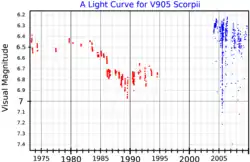 A visual band light curve for V905 Scorpii. The red points are from Sterken et al. (1997),[1] and the blue points are ASAS data.[2] | |
| Observation data Epoch J2000 Equinox J2000 | |
|---|---|
| Constellation | Scorpius |
| Right ascension | 17h 41m 59.025s[3] |
| Declination | −33° 30′ 13.71″[3] |
| Apparent magnitude (V) | 6.66[4] (6.3 - 6.9[5]) |
| Characteristics | |
| Spectral type | LBV |
| U−B color index | +0.30[4] |
| B−V color index | +1.21[4] |
| Variable type | LBV[5] |
| Astrometry | |
| Radial velocity (Rv) | -35[6] km/s |
| Proper motion (μ) | RA: −1.75[3] mas/yr Dec.: −1.49[3] mas/yr |
| Parallax (π) | 0.54 ± 0.54 mas[3] |
| Distance | 2,500[7] pc |
| Absolute magnitude (MV) | -8.9[8] |
| Details | |
| Mass | 13[8] M☉ |
| Radius | 150-330[5] R☉ |
| Luminosity | 290,000[7] L☉ |
| Surface gravity (log g) | 0.55[8] cgs |
| Temperature | 8,000-12,000[5] K |
| Rotational velocity (v sin i) | 45[5] km/s |
| Other designations | |
| Database references | |
| SIMBAD | data |
HD 160529 (V905 Scorpii) is a luminous blue variable (LBV) star located in the constellation of Scorpius. With an apparent magnitude of around +6.8 cannot be seen with the naked eye except under very favourable conditions, but it is easy to see with binoculars or amateur telescopes.
Physical characteristics

V905 Sco has a peculiar variable spectral type with emission lines and P Cygni profiles. At visual maximum it is similar to an A9 star and at minimum close to B8.[5] The distance has been estimated at 2.5 kiloparsecs (8,200 light years) based on the assumption of an absolute magnitude of -8.9.[8] However this distance is uncertain and values between 1.9 kiloparsecs and 3.5 kiloparsecs have been proposed.[5]
Working with a distance of 2.5 kiloparsecs, the radius varies from 150 R☉ when quiescent to 330 R☉ in outburst. The temperature also varies, from 8,000K in outburst to 12,000K when quiescent. With these parameters, the apparent visual magnitude varies by 0.5 and the bolometric luminosity is constant at 180,000 L☉.[5]
Estimates of the surface gravity lead to a mass of 13 M☉ and a probable initial mass of 25 M☉ This suggests that V905 Sco is a former red supergiant star.[8]
References
- ↑ Sterken, C.; van Genderen, A. M.; de Groot, M. (January 1997). "Cyclic Light Variations in LBVs". Astronomical Society of the Pacific Conference Series. 120 (Luminous Blue Variables: Massive Stars in Transition): 35. Bibcode:1997ASPC..120...35S. Retrieved 16 March 2022.
- ↑ "ASAS All Star Catalogue". The All Sky Automated Survey. Retrieved 8 December 2021.
- 1 2 3 4 5 Van Leeuwen, F. (2007). "Validation of the new Hipparcos reduction". Astronomy and Astrophysics. 474 (2): 653–664. arXiv:0708.1752. Bibcode:2007A&A...474..653V. doi:10.1051/0004-6361:20078357. S2CID 18759600.
- 1 2 3 Ducati, J. R. (2002). "VizieR Online Data Catalog: Catalogue of Stellar Photometry in Johnson's 11-color system". CDS/ADC Collection of Electronic Catalogues. 2237: 0. Bibcode:2002yCat.2237....0D.
- 1 2 3 4 5 6 7 8 Stahl, O.; Gäng, T.; Sterken, C.; Kaufer, A.; Rivinius, T.; Szeifert, T.; Wolf, B. (March 2003). "Long-term spectroscopic monitoring of the Luminous Blue Variable HD 160529". Astronomy and Astrophysics. 400: 279–291. arXiv:astro-ph/0212473. Bibcode:2003A&A...400..279S. doi:10.1051/0004-6361:20021908. S2CID 15409946.
- ↑ Gontcharov, G. A. (2006). "Pulkovo Compilation of Radial Velocities for 35 495 Hipparcos stars in a common system". Astronomy Letters. 32 (11): 759–771. arXiv:1606.08053. Bibcode:2006AstL...32..759G. doi:10.1134/S1063773706110065. S2CID 119231169.
- 1 2 Nazé, Y.; Rauw, G.; Hutsemékers, D. (2012). "The first X-ray survey of Galactic luminous blue variables". Astronomy & Astrophysics. 538: A47. arXiv:1111.6375. Bibcode:2012A&A...538A..47N. doi:10.1051/0004-6361/201118040. S2CID 43688343.
- 1 2 3 4 5 Sterken, C.; Gosset, E.; Juttner, A.; Stahl, O.; Wolf, B.; Axer, M. (July 1991). "HD 160529 - a New Galactic Luminous Blue Variable". Astronomy and Astrophysics. 247 (2): 383. Bibcode:1991A&A...247..383S.